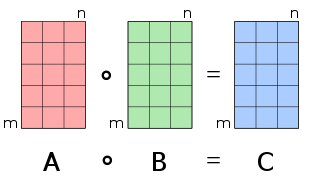Definition
Let be an n × n matrix. Consider any and any p × p submatrix of the form where:
Then A is a totally positive matrix if: [2]
for all submatrices that can be formed this way.
In mathematics, a totally positive matrix is a square matrix in which all the minors are positive: that is, the determinant of every square submatrix is a positive number. [1] A totally positive matrix has all entries positive, so it is also a positive matrix; and it has all principal minors positive (and positive eigenvalues). A symmetric totally positive matrix is therefore also positive-definite. A totally non-negative matrix is defined similarly, except that all the minors must be non-negative (positive or zero). Some authors use "totally positive" to include all totally non-negative matrices.
Let be an n × n matrix. Consider any and any p × p submatrix of the form where:
Then A is a totally positive matrix if: [2]
for all submatrices that can be formed this way.
Topics which historically led to the development of the theory of total positivity include the study of: [2]
For example, a Vandermonde matrix whose nodes are positive and increasing is a totally positive matrix.
In mathematics, the determinant is a scalar value that is a function of the entries of a square matrix. The determinant of a matrix A is commonly denoted det(A), det A, or |A|. Its value characterizes some properties of the matrix and the linear map represented by the matrix. In particular, the determinant is nonzero if and only if the matrix is invertible and the linear map represented by the matrix is an isomorphism. The determinant of a product of matrices is the product of their determinants.
In mathematics, a symmetric matrix with real entries is positive-definite if the real number is positive for every nonzero real column vector where is the transpose of . More generally, a Hermitian matrix is positive-definite if the real number is positive for every nonzero complex column vector where denotes the conjugate transpose of

In linear algebra, a symmetric matrix is a square matrix that is equal to its transpose. Formally,

In mathematics, a square matrix is a matrix with the same number of rows and columns. An n-by-n matrix is known as a square matrix of order . Any two square matrices of the same order can be added and multiplied.
In linear algebra, a diagonal matrix is a matrix in which the entries outside the main diagonal are all zero; the term usually refers to square matrices. Elements of the main diagonal can either be zero or nonzero. An example of a 2×2 diagonal matrix is , while an example of a 3×3 diagonal matrix is. An identity matrix of any size, or any multiple of it is a diagonal matrix called scalar matrix, for example, . In geometry, a diagonal matrix may be used as a scaling matrix, since matrix multiplication with it results in changing scale (size) and possibly also shape; only a scalar matrix results in uniform change in scale.
In mathematics, a Hermitian matrix is a complex square matrix that is equal to its own conjugate transpose—that is, the element in the i-th row and j-th column is equal to the complex conjugate of the element in the j-th row and i-th column, for all indices i and j:
In linear algebra, the adjugate or classical adjoint of a square matrix A is the transpose of its cofactor matrix and is denoted by adj(A). It is also occasionally known as adjunct matrix, or "adjoint", though the latter term today normally refers to a different concept, the adjoint operator which for a matrix is the conjugate transpose.
In linear algebra, a minor of a matrix A is the determinant of some smaller square matrix, cut down from A by removing one or more of its rows and columns. Minors obtained by removing just one row and one column from square matrices are required for calculating matrix cofactors, which in turn are useful for computing both the determinant and inverse of square matrices. The requirement that the square matrix be smaller than the original matrix is often omitted in the definition.
In linear algebra, a Hankel matrix, named after Hermann Hankel, is a square matrix in which each ascending skew-diagonal from left to right is constant, e.g.:

In mathematics, in particular functional analysis, the singular values of a compact operator acting between Hilbert spaces and , are the square roots of the eigenvalues of the self-adjoint operator .
In linear algebra and functional analysis, the partial trace is a generalization of the trace. Whereas the trace is a scalar valued function on operators, the partial trace is an operator-valued function. The partial trace has applications in quantum information and decoherence which is relevant for quantum measurement and thereby to the decoherent approaches to interpretations of quantum mechanics, including consistent histories and the relative state interpretation.
In linear algebra, the Gram matrix of a set of vectors in an inner product space is the Hermitian matrix of inner products, whose entries are given by the inner product . If the vectors are the columns of matrix then the Gram matrix is in the general case that the vector coordinates are complex numbers, which simplifies to for the case that the vector coordinates are real numbers.
In matrix theory, the Perron–Frobenius theorem, proved by Oskar Perron (1907) and Georg Frobenius (1912), asserts that a real square matrix with positive entries has a unique eigenvalue of largest magnitude and that eigenvalue is real. The corresponding eigenvector can be chosen to have strictly positive components, and also asserts a similar statement for certain classes of nonnegative matrices. This theorem has important applications to probability theory ; to the theory of dynamical systems ; to economics ; to demography ; to social networks ; to Internet search engines (PageRank); and even to ranking of American football teams. The first to discuss the ordering of players within tournaments using Perron–Frobenius eigenvectors is Edmund Landau.
In mathematics, we can define norms for the elements of a vector space. When the vector space in question consists of matrices, these are called matrix norms.
In mathematics, a Cauchy matrix, named after Augustin-Louis Cauchy, is an m×n matrix with elements aij in the form
In mathematics, a Euclidean distance matrix is an n×n matrix representing the spacing of a set of n points in Euclidean space. For points in k-dimensional space ℝk, the elements of their Euclidean distance matrix A are given by squares of distances between them. That is

In mathematics, a matrix is a rectangular array or table of numbers, symbols, or expressions, arranged in rows and columns, which is used to represent a mathematical object or a property of such an object.

In mathematics, the Hadamard product is a binary operation that takes in two matrices of the same dimensions and returns a matrix of the multiplied corresponding elements. This operation can be thought as a "naive matrix multiplication" and is different from the matrix product. It is attributed to, and named after, either French mathematician Jacques Hadamard or German mathematician Issai Schur.
In machine learning, the kernel embedding of distributions comprises a class of nonparametric methods in which a probability distribution is represented as an element of a reproducing kernel Hilbert space (RKHS). A generalization of the individual data-point feature mapping done in classical kernel methods, the embedding of distributions into infinite-dimensional feature spaces can preserve all of the statistical features of arbitrary distributions, while allowing one to compare and manipulate distributions using Hilbert space operations such as inner products, distances, projections, linear transformations, and spectral analysis. This learning framework is very general and can be applied to distributions over any space on which a sensible kernel function may be defined. For example, various kernels have been proposed for learning from data which are: vectors in , discrete classes/categories, strings, graphs/networks, images, time series, manifolds, dynamical systems, and other structured objects. The theory behind kernel embeddings of distributions has been primarily developed by Alex Smola, Le Song , Arthur Gretton, and Bernhard Schölkopf. A review of recent works on kernel embedding of distributions can be found in.
The Hawkins–Simon condition refers to a result in mathematical economics, attributed to David Hawkins and Herbert A. Simon, that guarantees the existence of a non-negative output vector that solves the equilibrium relation in the input–output model where demand equals supply. More precisely, it states a condition for under which the input–output system